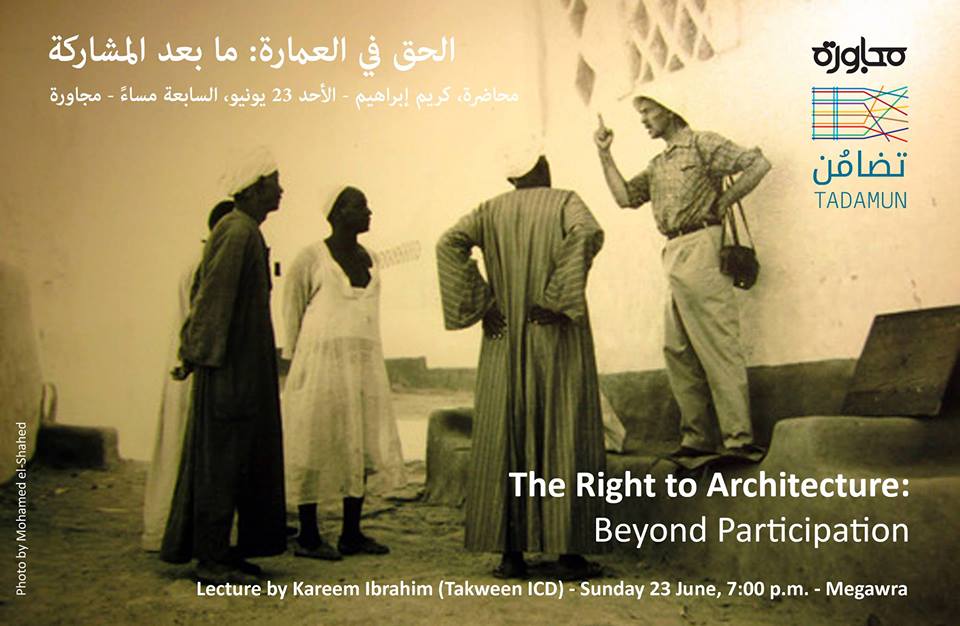Events
محاضرة ومعرض
Lecture
Kareem Ibrahim
23 Jun
2013 - 18 : 00
end23Jun
محاضرة
كريم إبراهيم
The Right to Architecture | Beyond Participation
The term ‘Right to Architecture’ assumes there are three elements: a right, people who claim the right, and custodians of the right. If local communities strive day after day to claim their right to architecture, are architects the custodians?
In fact, architects are often accused of serving only the rich and the ones who can afford their services. Architects are also accused of excluding the needs of their local communities when it comes to designing public buildings and spaces. Architects are accused that they are simply indifferent.
In some other cases architects start to care. As a result, they believe they are the custodians of the right to architecture. But such beliefs soon end up with failing attempts of social engineering. Hassan Fathy’s New Gourna and so as many similar projects are good examples of architects’ illusions of total control and ability to influence and shape people’s lives. Such architects believe they are the only ones who possess the wisdom, knowledge and ability to grant local communities their right to architecture.
In a world where local communities produce more than 90% of its built environment without the need for architects, should not architects be more realistic about their true influence? What would be the role of architects to support such local communities? How would architects escape the traps of either being indifferent or falling under illusions of social engineering and absolute control?
In fact, architects have many roles to play beyond their conventional practice and direct community participation models. The development of economic, social and cultural rights since the 1960s in different urban contexts around the world provides architects with more responsibilities towards their communities. These roles and responsibilities transcend the direct technical functions of today’s architect, to what is economic and political about their profession.
This lecture is an attempt to explore the parameters among which architects can find a role to support local communities. It also tries to identify what elements constitute the ‘Right to Architecture’ and how to work with local communities to claim it. And finally, it demonstrates the efforts of a group of Egyptian architects who strive to work with local communities, while trying to find practical mechanisms to sustain their daily business in today’s Egypt.
This lecture was first presented in April 2013 through the “Right to Architecture” symposium organized by Professor Nasser Rabbat and sponsored by the Aga Khan Program for Islamic Architecture (AKPIA) at the MIT (Boston). The content of this lecture is part of the efforts of TADAMUN: the Cairo Urban Solidarity Initiative aiming at encouraging citizens to claim their Right to the City and its democratic management.
This event is organized by TADAMUN (the Cairo Urban Solidarity Initiative) and Megawra (Built Environment Collective)
The lecture will be in Arabic
الحق في العمارة | ما بعد المشاركة
يَفترِض مصطلح "الحق في العمارة" وجود ثلاثة عناصر: حق، وأناس يطالبون بهذا الحق، وأشخاص مؤتمنين يمنحون هذا الحق للآخرين. فإذا كانت مجتمعاتنا المحلية تكافح يوماً بعد يوم للحصول على هذا الحق، فهل المعماريون هم المؤتمنون عليه؟
عادة ما يُتّهَم المعماريون بأن خدماتهم مقصورة على الأغنياء وفقط من يتحملون تكلفتها. يُتّهَم المعماريون أيضاً أنهم لا يلقون بالاً لاحتياجات مجتمعاتهم المحلية عندما يتعلق الأمر بتصميم المباني والفراغات العامة. ببساطة، يُتّهَم المعماريون بعدم المبالاة تجاه مجتمعاتهم.
في أحيان أخرى يبدأ المعماريون في الاهتمام بما حولهم. ونتيجة لذلك، يعتقدون أنهم "المؤتمنون" على "الحق في العمارة"، ولكن سرعان ما يقود هذا الاعتقاد إلى محاولات فاشلة للهندسة الاجتماعية ومحاولة لتنظيم المجتمع وقولبته على الطريقة التي يظن المعماريون أنها الأمثل لهذه المجتمع. فقرية "القرنة" لحسن فتحي، والعديد من المشروعات المماثلة، هي أمثلة جيدة على أوهام المعماري حول قدرته على التحكم والتأثير في حياة الناس وصياغتها بالطريقة التي يراها ملائمة. ويظن المعماري في هذه الحالة أنه الوحيد الذي يمتلك الحكمة والمعرفة والقدرة على منح المجتمعات المحلية "حقهم في العمارة".
في عالم تُنتِج فيه المجتمعات المحلية 90% من بيئتنا المشيدة بدون الحاجة إلى معماريين، ألا يتوجب على المعماريين أن يكونوا أكثر واقعية فيما يتعلق بقدرتهم على التأثير؟ ما الدور الذي يمكن أن يلعبه المعماريون لدعم مثل هذه المجتمعات المحلية؟ هل يمكن للمعماريين تجنب الوقوع في هذا الفخ: أما عدم المبالاة تجاه مجتمعاتهم، أو الغرق في أوهام قدرتهم على السيطرة المطلقة على هذه المجتمعات وصياغة طريقة حياتها؟
في الحقيقة، يمكن أن يلعب المعماريون أدواراً عديدة بما يتجاوز ممارستهم النمطية للمهنة، وبما يتجاوز أيضاً النماذج المباشرة للمشاركة المجتمعية في المشروعات المختلفة. فعلى سبيل المثال، يفرض تطور مفاهيم الحقوق الاقتصادية والاجتماعية والثقافية منذ ستينيات القرن الماضي المزيد من المسئوليات على المعماريين تجاه مجتمعاتهم. وتتخطى هذه الأدوار والمسئوليات الوظائف الفنية والتقنية المباشرة لمعماريي اليوم، إلى ما هو سياسي واقتصادي فيما يتعلق بمهنتهم.
تُعَد هذه المحاضرة محاولة لاستشراف الحدود التي يمكن أن يجد المعماريون لأنفسهم من خلالها دوراً لدعم مجتمعاتهم المحلية. وتحاول هذه المحاضرة أيضاً التعرف على العناصر التي تكوّن "الحق في العمارة"، وكيف يمكن العمل مع المجتمعات المحلية للحصول عليه. وأخيراً، تستعرض هذه المحاضرة جهود مجموعة من المعماريين المصريين للعمل مع مجتمعهم المحلي، أثناء محاولتهم الوصول لصيغة عملية لإدارة نشاطهم المهني.
تم تقديم هذه المحاضرة للمرة الأولى في إبريل 2013 من خلال سيمبوزيوم "الحق في العمارة" الذي نظمه بروفيسور ناصر رباط برعاية "برنامج الأغا خان للعمارة الإسلامية" في معهد ماساتشوستس للتكنولوجيا (بوسطن). بعد محتوى هذه المحاضرة أحد جهود مبادرة "التضامُن العمراني بالقاهرة" والهادفة إلى تشجع المواطنين على المطالبة بحقهم في المدينة وإداراتها بصورة ديموقراطية.
هذه الفعالية من تنظيم مبادرة التضامن العمراني بالقاهرة ومجاورة (جمعية الفكر العمراني)
المحاضرة باللغة العربية

